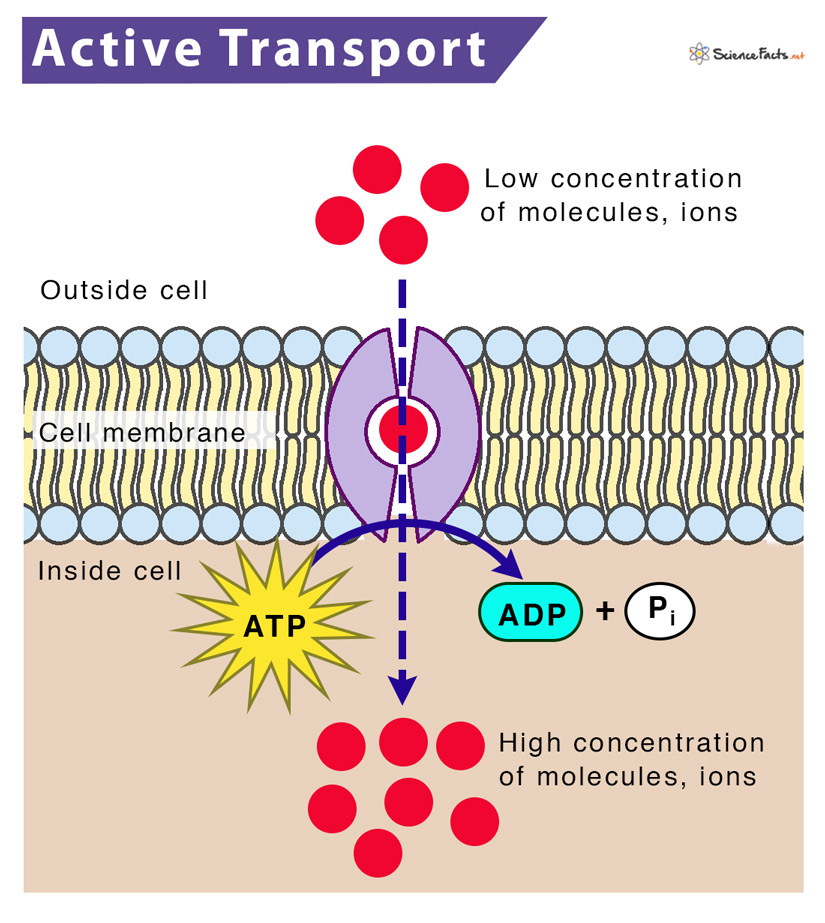
Active Transport
Active transport occurs across the cell membrane and allows molecules into or out of the cell. Active transport, unlike passive transport, requires energy because it moves the molecules against the concentration gradient or from low to high concentrations of solutes.
Because we are going against the concentration gradient, diffusion and other types of passive transport will not work. In fact, because active transport involves moving from a less crowded area to a more crowded area, it is the opposite of diffusion. Usually, active transport is carried out by transport proteins or pumps embedded in the cell membrane.
Often, active transport requires a carrier molecule to occur.
For example, carrier proteins can carry ions or molecules near the cell membrane across it. Charged ions, like sodium (Na) and potassium (K), cannot cross the cell membrane because the cell membrane does not “like” charged molecules and keeps them out. So, pumps like the sodium-potassium pump can move sodium ions against the concentration gradient.
You can think of diffusion as a boat moving down a river with the current. It doesn’t take any effort and a boat will naturally move downstream without help from a captain or motor.
Active transport, on the other hand, is when a boat needs to go against the current. So, to do this, it takes energy in the form of a motor or a person who can row the boat against the current.
An example of active transport is when a plant needs to get nutrients from the soil. The soil is less crowded and the inside of the plant is more crowded, so the plant will need to use energy to bring the nutrients from the soil into the plant tissues.
 Edited: 05 October 2022
Edited: 05 October 2022
Active Transport
Active transport occurs across the cell membrane and allows molecules into or out of the cell. Active transport, unlike passive transport, requires energy because it moves the molecules against the concentration gradient or from low to high concentrations of solutes.
Because we are going against the concentration gradient, diffusion and other types of passive transport will not work. In fact, because active transport involves moving from a less crowded area to a more crowded area, it is the opposite of diffusion. Usually, active transport is carried out by transport proteins or pumps embedded in the cell membrane.
Often, active transport requires a carrier molecule to occur.
For example, carrier proteins can carry ions or molecules near the cell membrane across it. Charged ions, like sodium (Na) and potassium (K), cannot cross the cell membrane because the cell membrane does not “like” charged molecules and keeps them out. So, pumps like the sodium-potassium pump can move sodium ions against the concentration gradient.
You can think of diffusion as a boat moving down a river with the current. It doesn’t take any effort and a boat will naturally move downstream without help from a captain or motor.
Active transport, on the other hand, is when a boat needs to go against the current. So, to do this, it takes energy in the form of a motor or a person who can row the boat against the current.
An example of active transport is when a plant needs to get nutrients from the soil. The soil is less crowded and the inside of the plant is more crowded, so the plant will need to use energy to bring the nutrients from the soil into the plant tissues.
 Edited: 05 October 2022
Edited: 05 October 2022
 Knowt
Knowt
